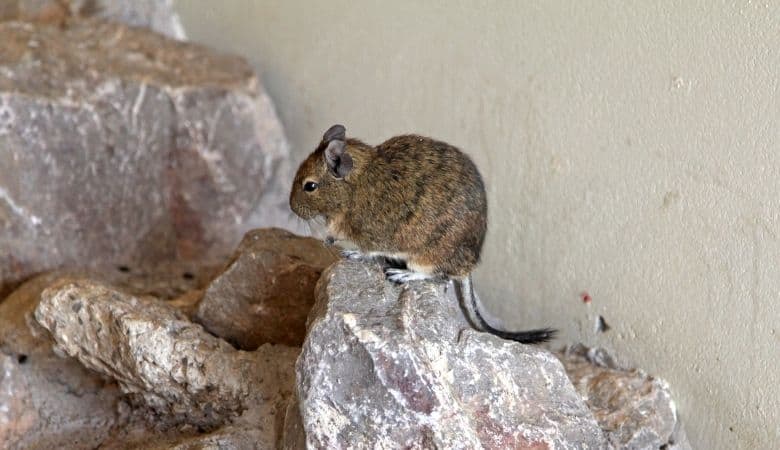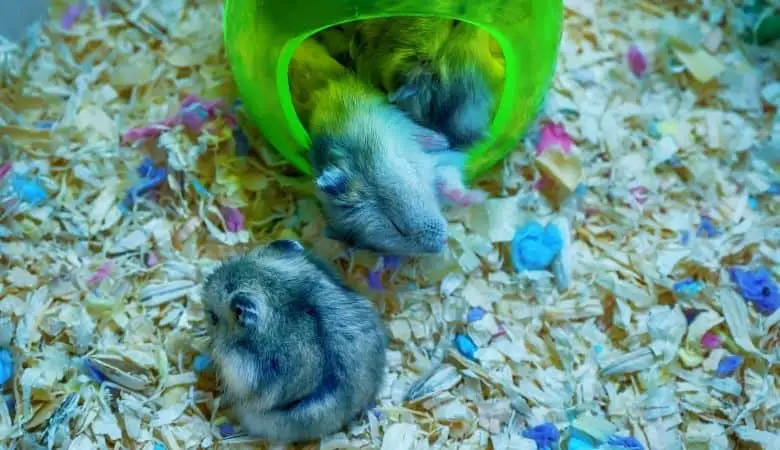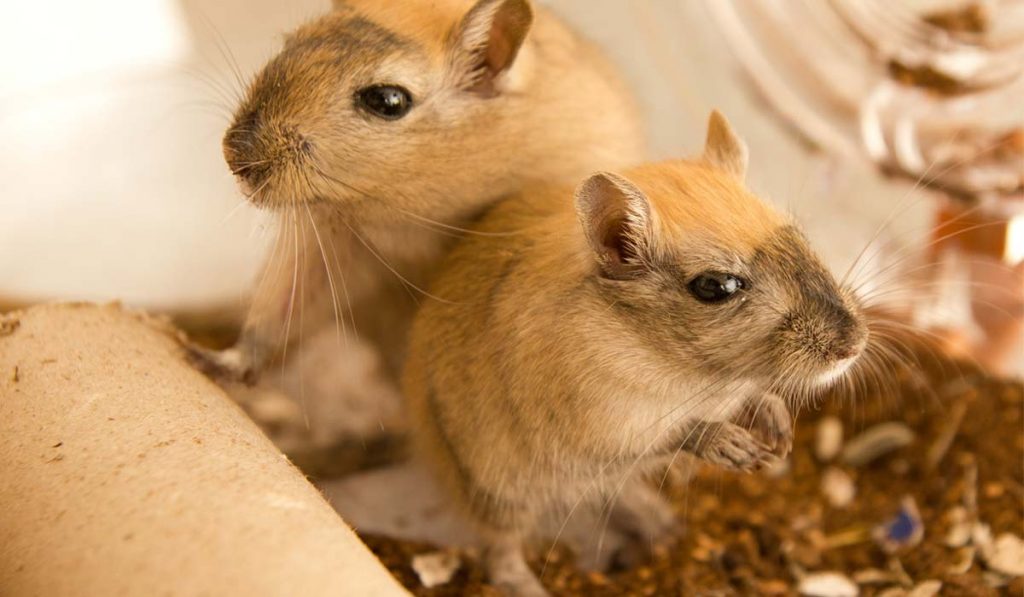Many parents get their children Gerbils as their first pet. To them, Gerbils can teach them about responsibility and how to care for pets. These small pets are often mistaken for hamsters. However, they aren’t the same. The only similarity is, they belong to the rodent animal group.
They are fidgety and fun once they develop a close bond with the owner. To do that, you need to accustom these tin rodents to your touch.
Gerbils can engage you and your child in hours of fun entertainment. So, are you interested in a gerbil? This article will highlight the initial cost, maintenance, and the different types of gerbils you can buy.
So, how much are you likely to spend on a pet gerbil annually? On average, you may spend up to around $400 annually. Here’s an approximation of the annual price range for the first year. I say first year since some of these costs is a one time expense only:
| Item | Cost |
| Initial purchase (the gerbil) | $10 to $100 |
| Housing | $60 to $100 |
| Beddings | $50 to $80 |
| Medical check-ups | $100 to $200 |
| Food | $70 to $100 |
| Toys | $40 |
| Carrier | $10 |
| Gerbil dust | $15-30 |
Keep in mind that these prices are only an approximation of the actual price. The prices may change depending on your state, neighborhood, pet store, or veterinarian. Always do your research before purchase.
Will they recognize you and appreciate your effort? You should see what I found out and wrote about that.
Types of Gerbil Breeds And How Much They Cost
Did you know there are over 100 breeds of a gerbil? Yeah! From the Mongolian gerbil to the Taterillus gerbil, many species live in the Asian and African deserts. However, not all gerbil breeds are suitable home pets.
Some are in tune with you so much that they can be taught their own name and much more. See here to find out.
Some American states do not provide licenses for gerbil ownership. Only a few species make wonderful and safe pets. They include the fat-tailed gerbils and the Mongolian gerbil.
1. Mongolian Gerbils

Mongolian gerbils are among the least expensive pets. On average, they cost about $10 to $20.
These pets originate from the grasslands and deserts in Mongolia and China. Also known as Meriones Unguiculactus, they are approximately 5-6 inches, with a 4-inch tail. They weigh 60-130g and are very easy to look after.
You also have the freedom to choose from a wide range of coat colors; Mongolian gerbils come in over 30 coat colors. You can pink a lilac gerbil, red gerbil, or black gerbil. It all depends on your preference.
Mongolian gerbils should live in pairs. They are social animals and can’t survive alone for an extended period. Also, their life span is about 2 to 5 years.
Overall Mongolian gerbils are active, curious, fun, and friendly. They love to run around their environment, exploring all corners. These rodents stay active during the day at night.
2. Fat-tailed Gerbils

Also known as Duprasi Gerbil, The fat-tailed gerbil will cost approximately $30 to $100. They are pricier compared to the Mongolian gerbil. But the rarity of fat-tailed gerbils could also be a determining factor in the pricing. You can only purchase a fat-tailed gerbil from a breeder who specializes in these rodents.
If that’s too pricey, you might have to travel to Northern Sahara. These pets thrive in the sparsely vegetated and rocky deserts of Algeria, Egypt, Libya, and Tunisia. In the desert, they live in one-meter deep burrows and feed on insects.
Fat-tailed gerbils weigh approximately 40-100g, with a 3 to 5-inch length and a 2-inch tail. They are also available in one unique color; sandy agouti. As for the life span, fat-tailed gerbils live longer than Mongolian gerbils. These rodents can survive for 2 to 8 years, depending on how well you take care of them.
Personality-wise, fat-tailed gerbils are laid-back, meek, a bit slow, and friendly. They also take several naps throughout the day and enjoy being carried around.
Although both gerbils are very affordable, they still need a lot of maintenance and care once they get to your house.
How to Fend For a Gerbil (The Maintenance Cost)
As you’ve already noticed by now, purchasing a gerbil is not expensive. However, you may need to prepare for the maintenance costs when you get a pet gerbil. Because gerbils are so small and fragile, they require utmost care and protection. So, how should you go about that?
1. Medical check-ups
Before and after purchase, you will need to stay on top of the gerbil’s health to avoid risking infections. Before purchase, you will need to ensure that the gerbil is healthy enough to join your family. However, the check-ups don’t stop once the pet is home.
You still have to go for regular veterinary visits to ensure the pet is healthy. In case you didn’t know, Mongolian gerbils are susceptible to diet-induced diabetes and epilepsy. On the other hand, fat-tailed gerbils easily catch colds or hyperthermia. Other conditions that affect gerbils include:
- Dental problems
- Ringworm
- Tyzzer’s disease
- Gerbils prone to tumors
- Parasite infections
Therefore, budgeting for regular vet clinic visits is essential. Here’s an approximation of the annual vet visits.
- $40 for scheduled exams
- $10 to $20 for medication
- $100 for emergency vet visits
- $200 for gland removal after tumor
Keep in mind that the costs above are an approximation. They can vary depending on the charges of your local vet clinic.
2. Gerbil enclosure/cage
The gerbil enclosure, also known as a gerbilarium, is generally more expensive than the actual gerbil. On average, the gerbil cage cost around $50-$100, depending on whether it’s ready-made or an assembly kit. A regular gerbilarium consists of two sections; the top part has metal bars, while the bottom part consists of glass. They play and feed in the top part and sleep at the bottom.
Since Mongolian gerbils thrive in pairs, they need ample space. Therefore, instead of buying two gerbilariums, you can buy one that is spacious enough for both. Mongolian’s cage should also feature a layer of playing materials that they can dig. Fat-tailed gerbils can thrive in smaller tanks with adequate space. A hamster’s cage can work well for a fat-tailed gerbil.
Here’s a perfect two section gerbil cage. Press the link or image below to learn more about it on Amazon:
Savic Habitat Metro – Gerbil & Hamster Cage
3. Beddings
Now that you have the housing on lock, where will the gerbils sleep? Since they are accustomed to living in tunnels, gerbils will often dig into their beddings to create artificial burrows. Therefore, gerbils need beddings; In fact, research has shown that gerbils can become stressed when they lack beddings. Gerbils make tunnels, chew them, and mix up the beddings to entertain them.
Reliable gerbil beddings can cost you approximately $50 to $100 annually. These two are our top recommended beddings, both are available in almost all pet stores and on Amazon:
However, if buying bedding is expensive, you can create homemade beddings. Here are a few ideas:
- Homemade paper towels. You can cut them, scrunch them up or shred them into tiny pieces.
- Shredded paper that doesn’t contain ink.
- Hay, which you can also use to create beddings for other pets in the house. However, if you want to buy hay, you’ll spend $40 for 178l of grass.
- Alternatively, you can make the beddings last longer by spot cleaning every day.
Once you have your bedding of choice, line the lower part of the cage with an appropriate bedding amount. It could be 4 inches or 8 inches, you’ll decide.
Keep in mind that wood shaving should be pet-friendly. Some wood shavings like pine and cedar contain phenols, which can be harmful to the gerbil. Dusty beddings are also not advisable. Lastly, it would be best if you cleaned the cage regularly to prevent infections.
4. Food
Mongolian and fat-tailed gerbils are omnivorous; they digest plants and animal food content. Apart from leafy greens and fruits, gerbils also need a unique food mix, which costs about $100 for each gerbil every 10-12 months.
The food is pricey because it is mixed explicitly for gerbils. The good thing is gerbils only eat tiny amounts of food. So, a packet of food mix can last for months.
The mix contains everything a gerbil needs to survive and stay active. The food mix ingredients are
- Seeds,
- Nuts,
- Hay,
- Corn,
- soy meal, and
- grains.
The gerbils need carbohydrates, protein, fats, vitamin A, phosphorus, and a broad range of minerals. All these minerals are in the food mix.
You can find the food mix in various pet stores as well as online. Here are our two recommended food mixes for gerbils, both are available on Amazon:
Alternatively, you can save money by feeding gerbils foods that are readily available. They include bread, bananas, lettuce, apples, carrots, etc. The only problem is, your gerbil might not get enough nutrients it needs. Therefore, instead of limiting the food mix, you can substitute it with regular food once in a while.
5. Feeding accessories
Just like hamsters, gerbils need appropriate feeding tools. Typically, this is a one-time purchase that costs around $10. The gerbils will need a feeding bowl and a small water dispenser in the gerbilarium.
While the feeding accessories are vital, take note of the materials. Not only can plastic become toxic to the gerbil’s health, but these little rodents also chew plastic. The bowls won’t last. Glass breaks easily, and metal can rust over time. Veterinarians often recommend ceramic feeding bowls and water dispensers.
6. Toys
Gerbils are very active animals. They enjoy digging and running around in their cages. But since you can’t entertain them all day, you need to invest in a few toys to keep them occupied.
Vets recommend installing an exercise wheel inside the gerbilarium to keep the gerbils active. Hard plastic wheels are the best to prevent them from chewing. These wheels range between $25 and $30. Alternatively, you can create a cardboard tube in place of the hard plastic exercise wheel. To get a quiet experience we recommend the Silent Runner wheel that you can learn more about over at Amazon here:
Also, it would help if you got chew toys for your gerbil. Naturally, gerbils love to chew. Therefore, if left without chew toys, the teeth can pierce the mouth leading to severe pain and infections. You can buy plain wood toys, dried hay toys, sandblasted grapevines, and other pet-friendly chew toys. These can range from $5 to $30, depending on the brand.
If you want to save money on toys, you can use egg boxes, inner tissue tubes, toilet paper rolls and thick cardboard.
But beware not to buy toys that have ink or paint as that can affect the gerbil. Additionally, metal toys tend to rust after some time.
7. Gerbil dust
To stay clean, gerbils love to roll around in the dust. The dust eliminates oils, parasites, and other uncomfortable dirt particles. Therefore, keeping a small bowl of dust in the cage is essential. On average, good-quality dust will cost you around $15.
Gerbils can take a dust bath at least once a week. All you have to do is prepare a bowl and leave it out for the rodents. Remember to sieve it through every few days to remove poop and other particles.
8. Gerbil carrier
Carriers are necessary, especially if you travel or move around a lot. They also come in handy when you have to go to the vet. Gerbils are very small and need to be in a safe and stable carrier. The carrier is affordable and will cost you around $10. You can find gerbil carriers at any pet store, as well a on Amazon here.
This Sounds Expensive…
After reading this article, you’re probably questioning the affordability of these rodents. The maintenance is more expensive than the initial purchase.
But the truth is gerbils are like any other pet when it comes to expenditure. They all rely on special meals, consistent vet visits, toys, and special housing. The only difference might be the fact that Gerbils are delicate pets and require a bit more maintenance.
Now that you know the cost of owning a pet gerbil, it’s time to find out how to select the right gerbil pet.
How to Select The Right Pet Gerbil

1. Health
Health is the most significant factor when selecting a gerbil. Gerbils are prone to various diseases, and if you bring home a sickly gerbil, it will die sooner than expected. Therefore, whether you’re adopting it from a shelter or buying it in a pet store, check the gerbil thoroughly for any signs of illness.
A healthy gerbil is active, curious, has bright shiny eyes, a clean pink nose, and no sign of injury. But if you see a gerbil that’s withdrawn, has a runny red nose, open wounds, or swollen eyes, it may not be a healthy gerbil.
2. Color
Flat-tailed gerbils have a distinct golden agouti color. But as mentioned earlier, Mongolian gerbils come in a broad range of coat colors. You can find a black, lilac, red, white, or Siamese (tan body and dark brown features) Mongolian gerbil, to name a few. If you like color, you can go for the Mongolian gerbil; if not, then the flat-tailed gerbil is perfect.
3. Price
Often the purchase price for gerbils ranges depending on the coat color and rarity of the gerbil. For example, you can only buy the flat-tailed gerbil from a specialized breeder. That makes it more expensive than the Mongolian. However, some Mongolian coat colors are also rare.
4. Number of gerbils o get
First and foremost, because Mongolian gerbils are social animals, they automatically come in pairs. Isolating a Mongolian gerbil can shorten their lifespan because they become lonely and stressed. However, flat-tailed gerbils can still thrive alone.
But if you’re a first-time gerbil buyer, you can buy 2 or 3 gerbils from the same litter. They have a higher chance of getting along once you bring them home. The only downside to getting more gerbils is the need for a spacious cage, which adds cost.
5. Gender
When it comes to gender, it all depends on your preferences. But here are a few things to note.
- Male gerbils are larger than female gerbils after they grow fully. The scent gland is also more extensive in the male gerbil.
- The female gerbil is more aggressive, and male gerbils bond faster with the owner and other pets.
To Sum it up
In conclusion, gerbils are fun and entertaining. Your kids can keep them as pets because they also don’t require 24/7 care. The annual maintenance cost is affordable, and there are several cheaper options for bedding, toys, and food within the household. Gerbils can be amazing furry friends.









